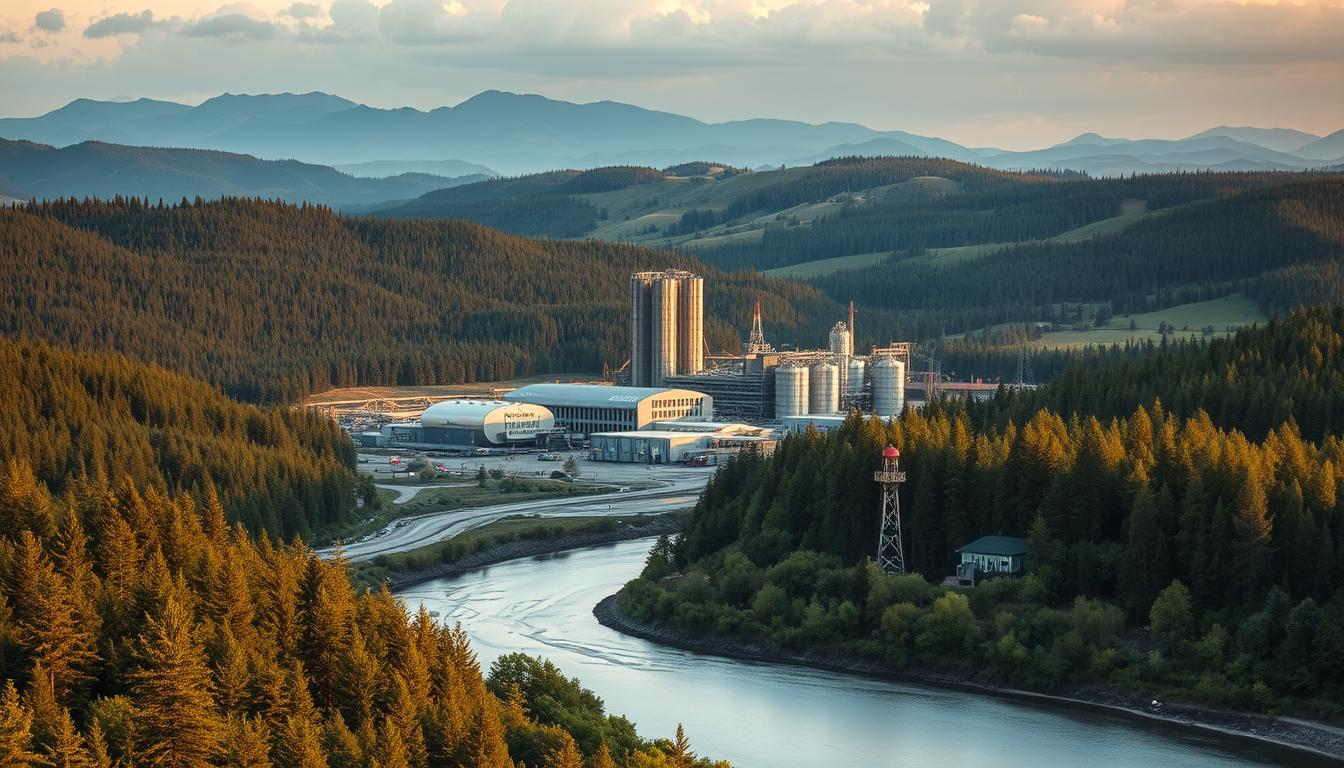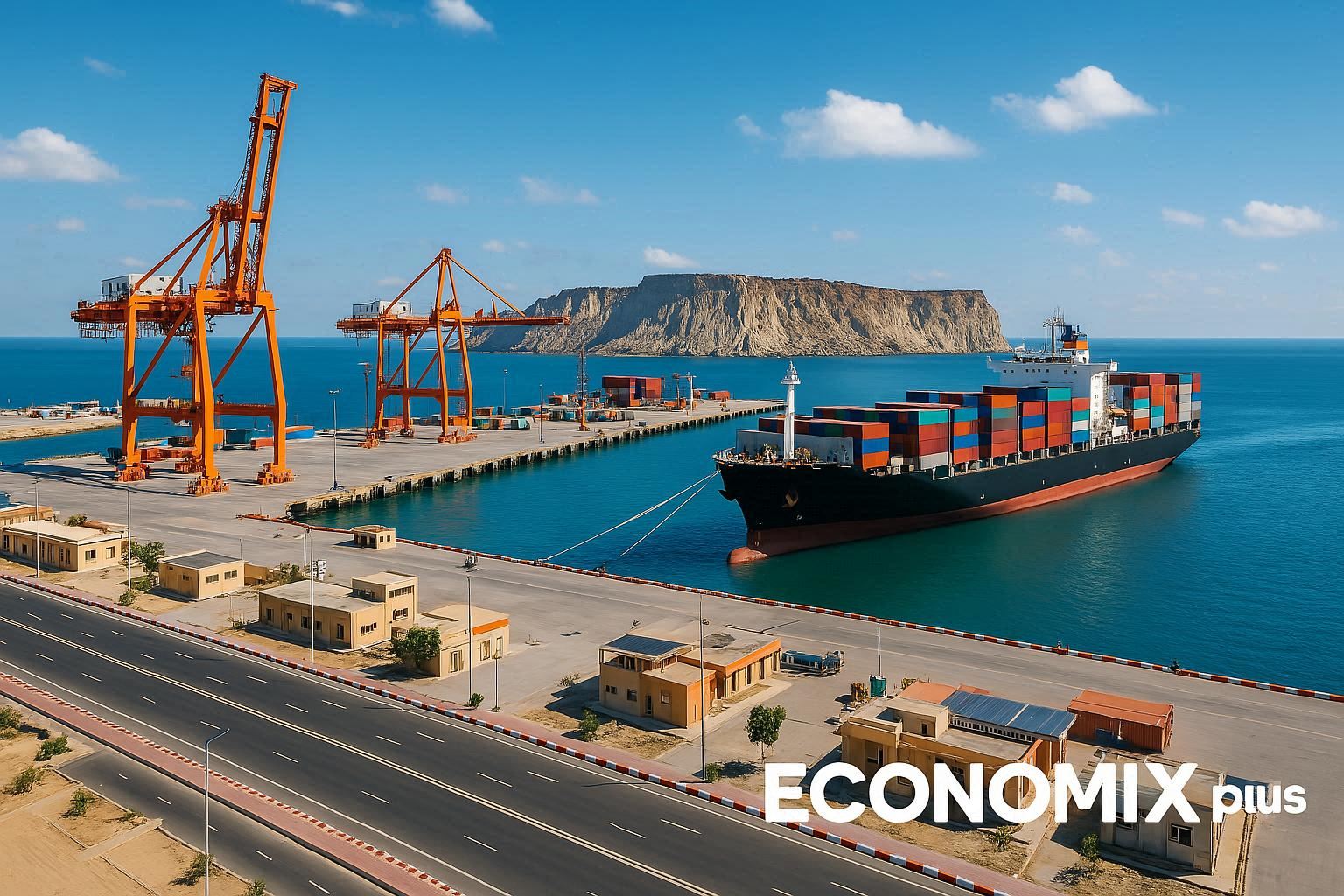As two resource-rich nations with vast land masses and relatively small populations, Australia and Canada face similar challenges in balancing economic growth with environmental stewardship.
Can a country rich in natural resources achieve economic prosperity without compromising its environmental integrity? This is a question that has puzzled government policymakers and industry leaders in both Canada and Australia.
The economies of both countries are driven by the export of energy products, including crude oil, natural gas, and LNG. However, their approaches to managing the environmental impacts of resource development differ.
Key Takeaways
- Comparison of Australia and Canada’s approaches to resource development and environmental stewardship.
- Analysis of economic contributions, regulatory frameworks, indigenous relations, and environmental policies.
- Insights into the strengths and weaknesses of each country’s approach to resource management.
- Valuable lessons for other resource-rich nations.
- Different approaches to managing resource development and their varying results.
Geographic and Demographic Profiles
When examining the balance between resources and development, understanding the geographic and demographic profiles of Australia and Canada is crucial. Both countries are known for their vast territories and rich natural resources, which play a significant role in their economies.
Land Mass and Population Distribution
Australia and Canada are among the largest countries in the world by land area. Australia’s land mass is approximately 7.7 million square kilometers, while Canada spans around 10.08 million square kilometers. Despite their vast sizes, both countries have relatively small populations. Australia’s population is about 25 million, while Canada’s is around 38 million. The population distribution in both nations is often characterized by coastal concentration, with many major cities located near the coast.
In Australia, the population is heavily concentrated along the eastern coast, particularly in cities like Sydney and Melbourne. Similarly, in Canada, a significant portion of the population resides in the southern parts of the provinces of Ontario and Quebec, with major cities like Toronto and Montreal. This coastal and regional concentration affects the distribution of infrastructure and services, influencing the development of the resource sector in more remote areas.
Natural Resource Endowments
Both Australia and Canada are endowed with significant natural resources, which are crucial to their economy. The resource sector in both countries includes a wide range of minerals, energy resources, and other valuable commodities. Australia is a leading producer of iron ore, coal, and gold, while Canada is rich in oil, natural gas, and various minerals, including uranium and potash.
The distribution and accessibility of these resources vary across different regions within both nations. In Australia, many mineral resources are found in Western Australia, particularly in the Pilbara region, known for its iron ore deposits. In Canada, the oil sands of Alberta are a significant source of oil, while natural gas is found in various parts of the country, including British Columbia and Nova Scotia.
The geographic location of these resources relative to population centers and export markets significantly affects development strategies and costs. For instance, transporting resources from remote areas to ports for export can be costly and logistically challenging. However, both Australia and Canada have invested heavily in infrastructure to facilitate the transport of resources, thereby supporting their economy and global competitiveness.
In conclusion, the geographic and demographic profiles of Australia and Canada provide valuable insights into how these nations manage their natural resources and balance development. Understanding these profiles is essential for analyzing the economic importance of the resource sector and its impact on national development strategies.
Historical Context of Resource Development
The resource development sector has played a significant role in shaping the economies of Australia and Canada, with a history that spans centuries. As we delve into the historical context of resource development in these countries, it becomes evident that understanding their past is crucial for analyzing their current state and future prospects.
Australia’s Resource Development Timeline
Australia’s resource development history began with the early exploitation of mineral resources, particularly gold, in the mid-19th century. This period marked the beginning of significant economic growth driven by the resource sector. Over time, Australia has continued to expand its resource development, incorporating new technologies and extraction methods to manage its diverse natural resources.
The development of Australia’s resource sector has been influenced by various factors, including government policies, technological advancements, and market demand. For instance, the discovery of iron ore and coal reserves in Western Australia and Queensland led to a significant increase in mining activities, transforming the regional economy and contributing substantially to the country’s GDP.
| Period | Key Events | Economic Impact |
|---|---|---|
| Mid-19th century | Gold rush and initial mineral extraction | Initial economic growth |
| Late 20th century | Expansion of iron ore and coal mining | Significant increase in GDP |
| Early 21st century | Adoption of new mining technologies | Improved efficiency and productivity |
Canada’s Resource Exploitation History
Canada’s resource development history is characterized by the early fur trade and subsequent exploitation of various natural resources, including timber, minerals, and energy resources. The country‘s vast geography and diverse geology have made it rich in natural resources, influencing its economic development and trade relationships, particularly with the United States.
According to PricewaterhouseCoopers (PwC) Canada, a decade ago, Canada’s oil and gas industry was recovering from the 2008 global financial crisis, facing challenges such as “weakened commodity prices, high supply costs misaligned with current prices, and disrupted capital markets.” This historical context is crucial for understanding the current state of Canada’s resource sector and the process of resource development.
- The fur trade and early resource extraction laid the foundation for Canada’s resource development.
- The gold rushes and subsequent development of oil sands and other resource extraction industries have been pivotal in shaping Canada’s economy.
- Canada’s resource development has been influenced by its relationship with the United States and the historical importance of north-south trade patterns.
Understanding the historical context of resource development in both Australia and Canada provides valuable insights into their current challenges and approaches to managing their natural resources. As these countries continue to evolve, their histories serve as a foundation for future development strategies.
Economic Importance of Natural Resources
Natural resources play a crucial role in shaping the economic landscapes of Australia and Canada. The abundance of natural resources in these countries has significantly contributed to their economic growth and stability.

Contribution to GDP
The extraction and processing of natural resources make a substantial contribution to the Gross Domestic Product (GDP) of both Australia and Canada. In Australia, the mining sector is a major driver of economic activity, while in Canada, the energy sector plays a pivotal role.
The mining sector in Australia accounts for a significant portion of the country’s GDP. According to recent statistics, the mining industry contributes around 10% of Australia’s GDP, making it one of the largest sectors in the economy. This contribution is primarily due to the extraction and export of minerals such as iron ore, coal, and gold.
- The mining industry in Australia is a significant employer, providing jobs to thousands of workers directly and indirectly.
- The sector also drives infrastructure development, including transportation networks and ports.
- The revenue generated from mining activities contributes to government coffers through royalties and taxes.
In Canada, the energy sector is a crucial component of the economy. The extraction of crude oil, natural gas, and other energy resources contributes significantly to Canada’s GDP. The energy sector is also a major driver of economic activity in provinces such as Alberta and Saskatchewan.
- The energy sector in Canada is a significant contributor to the country’s export revenue.
- The sector is a major employer, with thousands of workers employed in various capacities.
- The energy industry drives investment in infrastructure, including pipelines and processing facilities.
Export Revenue Generation
Both Australia and Canada are major exporters of natural resources, with their economies bolstered by trade, particularly the export of energy products such as crude oil, natural gas, and LNG.
The export of natural resources is a vital component of Australia’s trade balance. The country is one of the world’s largest exporters of iron ore, coal, and gold. The revenue generated from these exports is crucial for Australia’s economic stability.
In Canada, the export of energy products is a significant contributor to the country’s trade balance. Canada is a major exporter of crude oil and natural gas to the United States and other global markets. The revenue generated from these exports helps to stabilize the Canadian economy and supports growth in various sectors.
The export orientation of different resource sectors in both countries varies, with differences in market access and trade patterns. Understanding these dynamics is crucial for analyzing the economic importance of natural resources in Australia and Canada.
As major global resource suppliers, both countries are influenced by global market conditions. Fluctuations in global commodity prices can significantly impact the revenue generated from natural resource exports, affecting the overall economic stability of both nations.
Investment Trends in Resource Sectors
The resource sector is a critical component of both Australia and Canada’s economies, with investment trends playing a significant role in shaping their economic futures. Understanding these trends is essential for analyzing the health and prospects of the resource industry in both countries.
Australia’s Capital Investment Landscape
Australia’s resource sector has experienced significant fluctuations in capital investment over the years, influenced by factors such as commodity prices, market demand, and regulatory environments. The country’s robust mining industry has been a major attractor for investment, with a strong focus on iron ore, coal, and gold.
Key investment trends in Australia’s resource sector include:
- Increased investment in technology to improve operational efficiency and reduce costs.
- A shift towards more sustainable and environmentally friendly practices.
- Continued exploration and development of new resource projects.
The Australian government has implemented policies aimed at attracting foreign investment, which has contributed to the growth of the sector. However, the industry faces challenges such as rising production costs and environmental concerns, which can impact investment decisions.

Canada’s Capital Investment Challenges
Canada’s resource sector, particularly the oil and gas industry, has faced significant challenges in attracting and maintaining capital investment. Between 2010 and 2019, cumulative capital investment in the Canadian oil and gas extraction sector was C$494.3 billion, with annual investment ranging from as high as $76.1 billion in 2014 to as low as $33.3 billion in 2019.
The decline in investment is attributed to several factors, including low energy prices, regulatory uncertainty, and concerns around market access. The COVID-19 pandemic further exacerbated these challenges, impacting the medium- to long-term prospects for investment in the sector.
Key challenges facing Canada’s resource sector include:
- Regulatory uncertainty and a less than favourable regulatory regime.
- Lack of market access, particularly for oil and gas exports.
- Environmental opposition and concerns around the social license to operate.
To revitalize investment in the resource sector, Canada needs to address these challenges by improving the regulatory framework, enhancing market access, and promoting a more favourable investment climate.
Employment and Workforce Development
The resource sector’s contribution to employment and workforce development is a vital component of the economies of Australia and Canada. As both countries continue to navigate the complexities of resource development, understanding the impact on employment is crucial for policymakers and industry stakeholders.
Job Creation in Australia’s Resource Sector
Australia’s resource sector has been a significant source of employment opportunities, driving job creation in various regions. The sector’s growth has led to an increase in demand for skilled workers, contributing to the development of a robust workforce. In recent years, the Australian government has implemented initiatives aimed at enhancing vocational training and education programs, ensuring that the workforce is equipped to meet the evolving needs of the industry.
The resource sector’s contribution to employment in Australia is multifaceted. Not only does it provide direct jobs in mining and extraction, but it also stimulates indirect employment through supporting industries such as logistics and services. This has a positive ripple effect on regional economies, contributing to overall economic growth and development.

Employment Trends in Canada’s Resource Industries
In Canada, the resource sector also plays a vital role in employment, although trends have been somewhat different from those in Australia. In 2019, there were 55,853 people directly employed in the Canadian oil and gas extraction sector, representing an increase of just over 8% from 51,686 in 2010. However, direct employment in Canada’s oil and gas extraction sector has been relatively stagnant over the past decade, with medium-term prospects tempered by challenges such as lack of market access and regulatory concerns.
The Canadian resource sector faces unique challenges that impact employment trends. Technological changes, market access issues, and regulatory uncertainty have all contributed to a complex employment landscape. The geographic concentration of resource employment in provinces like Alberta has also led to regional economic disparities, highlighting the need for targeted policies to address these issues.
To generate employment growth from its resource sectors, Canada must navigate these challenges effectively. This involves not only addressing regulatory and market access issues but also investing in workforce development programs that prepare Canadians for the jobs of the future. By doing so, Canada can maximize the benefits of its resource endowments and create sustainable employment opportunities.
Government Revenue from Resource Extraction
Resource extraction plays a crucial role in the fiscal policies of Australia and Canada, providing substantial government revenue. The extraction of natural resources, including oil, gas, and minerals, generates significant income for both countries through various taxation and royalty systems.
Australia’s Taxation and Royalty Systems
Australia’s approach to collecting government revenue from resource extraction involves a combination of federal and state/territory taxation policies. The federal government imposes corporate income tax on the profits made by resource extraction companies, while state and territory governments collect royalties on the value of the resources extracted within their jurisdictions.
The royalty rates vary across different states and territories, reflecting the diverse geological and economic conditions. For instance, Western Australia, which is rich in iron ore and other minerals, has a complex royalty system that takes into account the type of mineral, its value, and the costs associated with its extraction.
Key components of Australia’s taxation system include:
- Corporate income tax on profits from resource extraction
- Royalties collected by state and territory governments
- Varied royalty rates across different jurisdictions
Canada’s Resource Revenue Collection
Canada’s system for collecting government revenue from resource extraction is complex, involving both federal and provincial taxation policies. The federal government collects corporate income tax, while provincial governments impose royalties and other fees on resource extraction activities.
Between 2009 and 2018, the Canadian oil and gas extraction sector generated over C$173.3 billion in government revenues, averaging C$492 per person annually. This revenue is crucial for provinces like Alberta, which has significant oil sands deposits.
Canada’s resource revenue systems vary significantly by province, creating different fiscal regimes for similar resources across the country. This variability can impact investment decisions and the overall development of the resource sector.
Key aspects of Canada’s resource revenue collection include:
- Federal corporate income tax on resource extraction profits
- Provincial royalties and fees on resource extraction
- Variability in fiscal regimes across provinces
The response of Canada’s resource revenue systems to price volatility is critical, as fluctuations in global commodity prices can significantly affect government fiscal planning. Understanding the strengths and weaknesses of Canada’s approach to resource taxation is essential for evaluating its impact on development decisions.
Regulatory Frameworks and Approval Processes
Effective regulatory frameworks are critical for the sustainable development of resources in both Australia and Canada, influencing investment decisions and project timelines. The regulatory environments in these countries play a pivotal role in shaping the resource sectors, with significant implications for economic outcomes, environmental protection, and social responsibility.
Australia’s Regulatory Environment
Australia is known for having a relatively streamlined regulatory process for resource development. The country’s regulatory framework is designed to balance the need for economic development with environmental and social considerations. The Environment Protection and Biodiversity Conservation Act 1999 is a key piece of legislation that governs environmental assessments and approvals for major projects.
Australia’s regulatory environment is characterized by:
- Clear guidelines for environmental assessments
- A centralized approval process for major projects
- Strong emphasis on public consultation and community engagement
The Australian government has implemented various measures to improve the efficiency of the regulatory process, including the use of advanced technologies and data analytics to streamline environmental assessments.
Canada’s Regulatory Challenges
Canada’s regulatory framework for resource development is more complex, involving multiple jurisdictions and overlapping processes. The Canadian Energy Research Institute (CERI) has highlighted that Canada faces a competitive disadvantage compared to the U.S., particularly in LNG projects and interprovincial oil and natural gas pipelines, due to lengthy approval timelines and regulatory uncertainty.
| Regulatory Aspect | Canada | Australia |
|---|---|---|
| Approval Timelines | Additional 13-19 months for LNG projects | Streamlined process with clearer timelines |
| Regulatory Uncertainty | High due to overlapping jurisdictions | Lower due to centralized approval process |
| Environmental Assessments | Complex and time-consuming | Clear guidelines and efficient process |
Canada’s regulatory challenges are further complicated by the need for Indigenous consultation and the potential for court challenges, which can significantly delay project timelines and increase costs. The Canadian government has been working to address these challenges by reviewing and reforming its regulatory processes, including changes to environmental assessment legislation.
The impact of regulatory uncertainty on investment decisions in Canada’s resource sectors is significant. Investors require clarity and predictability in the regulatory process to make informed decisions. Lengthy and uncertain approval timelines can deter investment, affecting the competitiveness of Canada’s resource sector.
In conclusion, while both Australia and Canada face challenges in their regulatory frameworks, Australia’s more streamlined approach provides a contrast to Canada’s complex and often lengthy processes. Understanding these differences is crucial for investors, policymakers, and stakeholders in the resource development sector.
Environmental Policies and Sustainability Practices
The pursuit of resource development in Australia and Canada is increasingly being shaped by stringent environmental policies and sustainability practices. As both countries continue to exploit their natural resources, they are also implementing measures to mitigate the environmental impacts of these activities.
Australia’s Environmental Management Approach
Australia has adopted a comprehensive environmental management framework to oversee its resource development activities. The country’s approach is characterized by a mix of federal and state-level regulations.
The Australian government has implemented the Environment Protection and Biodiversity Conservation Act 1999 (EPBC Act), which provides a legal framework for protecting the environment and conserving biodiversity. Under this act, any project that may have a significant impact on the environment must undergo a rigorous assessment and approval process.
“The EPBC Act is a crucial tool in ensuring that Australia’s environmental heritage is protected for future generations.”
Australia’s environmental management approach also includes the use of Strategic Assessments and Bioregional Assessments. These tools help in evaluating the potential environmental impacts of resource development projects and in developing strategies to mitigate these impacts.
| Environmental Management Tool | Description | Application |
|---|---|---|
| EPBC Act | Legal framework for environmental protection | Assessment and approval of projects with significant environmental impact |
| Strategic Assessments | Evaluation of environmental impacts at a strategic level | Development of policies and programs |
| Bioregional Assessments | Assessment of environmental values and potential impacts | Resource development projects in specific bioregions |
Canada’s Environmental Protection Measures
Canada has also implemented a robust environmental protection framework to regulate its resource development activities. The Canadian government’s approach is focused on ensuring that resource development is carried out in a sustainable and environmentally responsible manner.
Canada’s environmental assessment process is governed by the Canadian Environmental Assessment Act, 2012 (CEAA 2012). This legislation requires that any project with potential environmental impacts undergo a comprehensive environmental assessment.
The Canadian government has also introduced Impact Assessment legislation, which came into effect in 2020, replacing CEAA 2012. This new framework provides for a more comprehensive and inclusive assessment process, considering not only environmental impacts but also social and economic factors.
Canada’s environmental protection measures also include the development of climate policies that affect resource development. The government has implemented a carbon pricing policy and has set emissions reduction targets to mitigate the impacts of climate change.
- Canada’s approach to environmental assessment has become increasingly comprehensive, considering a wide range of factors beyond just environmental impacts.
- The country’s climate policies are influencing resource development, with a focus on reducing greenhouse gas emissions.
- Environmental considerations are becoming central to regulatory decisions, affecting project approvals and timelines.
In conclusion, both Australia and Canada are striving to strike a balance between resource development and environmental protection. While they share some similarities in their approaches, there are also distinct differences reflecting their unique environmental contexts and policy priorities.
Indigenous Relations and Land Rights
The intersection of resource development and Indigenous rights is a complex and evolving issue in Australia and Canada. As both countries continue to develop their natural resources, the need to balance economic growth with the rights and interests of Indigenous peoples has become increasingly important.
Aboriginal Engagement in Australian Resource Development
In Australia, the engagement of Aboriginal peoples in resource development has seen significant progress in recent years. The Australian government has implemented various initiatives aimed at improving the consultation process and ensuring that Aboriginal communities benefit from resource projects.
One of the key aspects of Aboriginal engagement is the negotiation of land access agreements. These agreements provide a framework for resource companies to access Aboriginal land while ensuring that the local communities receive fair benefits and are involved in the decision-making process.
The use of impact-benefit agreements has become more prevalent, allowing Aboriginal communities to participate in the economic opportunities created by resource development. This approach not only fosters better relationships between resource companies and Aboriginal communities but also contributes to more sustainable and equitable development outcomes.
First Nations Participation in Canadian Resource Projects
In Canada, the participation of First Nations in resource projects has evolved significantly, driven by legal decisions and changing societal expectations. The Canadian government has established a legal framework that requires resource companies to consult with and accommodate First Nations communities.
The duty to consult is a critical component of this framework, ensuring that First Nations are involved in the decision-making process regarding resource development on their traditional lands. This process has led to the development of more collaborative approaches to resource development, with a focus on creating opportunities for First Nations to benefit from these projects.
Impact-benefit agreements have also become a common practice in Canada, providing a mechanism for resource companies to work with First Nations communities to address concerns and create mutually beneficial outcomes. These agreements can include provisions for employment, training, and equity participation, thereby enhancing the access of First Nations to the economic opportunities generated by resource development.
| Aspect | Australia | Canada |
|---|---|---|
| Legal Framework | Native Title Act | Duty to Consult |
| Community Engagement | Land access agreements | Impact-benefit agreements |
| Economic Benefits | Royalties and employment | Equity participation and training |
In conclusion, both Australia and Canada have made significant strides in improving Indigenous relations and land rights in the context of resource development. While there are differences in their approaches, both countries recognize the importance of engaging with Indigenous communities and creating benefits for them. As the resource development sector continues to evolve, it is likely that we will see further innovations in this area, ultimately contributing to more equitable outcomes for all stakeholders involved in the country‘s resource development.
Australia and Canada: Who strikes a better balance between resources and development?
In the realm of resource development, Australia and Canada present contrasting models that highlight the complexities of balancing economic, social, and environmental factors. Both countries are rich in natural resources, including oil, gas, and minerals, and have been significant players in the global resource market. However, their approaches to resource development have differed, leading to varying outcomes in terms of economic benefits, environmental impacts, and social consequences.
Economic Outcomes: A Comparative Analysis
The economic outcomes of resource development in Australia and Canada can be assessed by examining the GDP growth and employment trends in their respective resource sectors. According to the data, Australia’s oil and gas extraction sector GDP rose by 51.7% between 2007 and 2016, while Canada’s oil and gas extraction sector GDP fell by 65.0% during the same period.
| Country | GDP Change (2007-2016) | Employment Change (2010-2019) |
|---|---|---|
| Australia | 51.7% increase | 195% increase (12,919 to 38,116) |
| Canada | 65.0% decrease | 8% increase (51,686 to 55,853) |
The data indicates that Australia’s resource sector experienced significant growth, both in terms of GDP and employment, compared to Canada. This divergence can be attributed to various factors, including differences in investment trends, regulatory frameworks, and market conditions.
Social and Environmental Trade-offs
The social and environmental trade-offs associated with resource development in Australia and Canada are critical aspects to consider. Both countries have faced challenges in balancing economic benefits with environmental protection and social responsibility.
Australia’s approach to resource development has been characterized by large-scale mining and gas projects, which have raised concerns about environmental impacts, including habitat destruction and pollution. On the other hand, Canada has also faced environmental challenges, particularly in the context of oil sands development, which has significant implications for greenhouse gas emissions and water usage.
In terms of social impacts, both countries have experienced effects on local communities and Indigenous populations. In Australia, there have been concerns about the impact of resource development on Aboriginal communities, while in Canada, First Nations communities have raised concerns about the effects of resource development on their lands and livelihoods.
The management of boom-bust cycles inherent in resource development is another critical aspect. Australia’s resource sector has experienced significant fluctuations, with implications for social stability and regional development. Canada has also faced similar challenges, with the added complexity of managing the economic and social impacts of resource development in remote and Indigenous communities.
In conclusion, both Australia and Canada face challenges in achieving a balance between economic development and social/environmental considerations in their resource sectors. While Australia has experienced significant economic growth, it has come with environmental and social costs. Canada, on the other hand, has struggled with declining GDP in its oil and gas sector, despite some employment growth.
The comparison between Australia and Canada highlights the need for a nuanced approach to resource development, one that balances economic benefits with environmental protection and social responsibility. By examining the contrasting models of these two countries, we can gain valuable insights into the complexities of achieving a sustainable and equitable balance between resources and development.
International Trade Relationships
International trade relationships are vital for the economic prosperity of resource-rich countries like Australia and Canada. Both nations have economies that are significantly influenced by their ability to export resources to global markets. The dynamics of international trade can either bolster or hinder their resource development strategies.
The export market strategies of Australia and Canada differ in several key aspects, particularly in terms of their market diversification and the challenges they face in accessing new markets. Australia has been successful in diversifying its export markets, particularly towards the growing economies in the Asia-Pacific region.
Australia’s Strategic Export Markets
Australia’s strategic approach to export markets has been a key factor in its economic success. By focusing on the Asia-Pacific region, Australia has been able to capitalize on the rapid economic growth of countries like China and India. This strategic focus has enabled Australia to reduce its dependence on any single market, thereby mitigating the risks associated with market fluctuations.
As noted by a trade expert, “Australia’s ability to adapt to changing global market conditions has been crucial in maintaining its competitive edge in the resource sector.” The country’s robust trade agreements and infrastructure development have further enhanced its market access to key regions.
Canada’s Market Access Challenges
Canada, on the other hand, has faced significant challenges in diversifying its export markets beyond the United States. The country’s historical reliance on the US market has made it vulnerable to changes in US energy production levels. As US domestic production of oil and natural gas increased, Canada’s exports to the US faced significant competition, impacting Canada’s resource development sector.
“Canada’s over-reliance on the US market has exposed its resource sector to significant risks, highlighting the need for diversification,” according to a resource industry analyst.
Canada has been working to develop new export infrastructure, including LNG terminals and oil pipelines, to improve its access to global markets, particularly in the Asia-Pacific region. However, these projects have faced numerous obstacles, including regulatory hurdles and economic viability concerns.
The challenges faced by Canada underscore the importance of developing diversified export markets and improving market access. By doing so, countries can reduce their vulnerability to fluctuations in any single market and enhance their economic resilience in the global world.
Technological Innovation in Resource Industries
Australia and Canada are leveraging technology to enhance their resource industries, improving efficiency and reducing costs. The integration of advanced technologies is transforming the way resources are extracted, processed, and managed.
Australia’s Adoption of New Technologies
Australia’s resource industry has been at the forefront of adopting new technologies to improve operational efficiency and reduce environmental impact. The use of automation, artificial intelligence, and data analytics is becoming increasingly prevalent.
Automation is being used in mining operations to improve safety and reduce labor costs. For instance, autonomous haulage systems are being implemented in several mines, allowing for continuous operation without the need for human intervention.
The adoption of advanced technologies is also enabling Australian companies to explore new opportunities in the resource sector. For example, the use of drones and satellite imaging is improving the accuracy of geological surveys and enhancing the exploration process.
Canada’s Innovation Landscape
Canada’s resource industry is also experiencing significant technological innovation, particularly in the areas of oil sands production and environmental management. Canadian companies are developing technologies to reduce costs and environmental impacts, particularly in challenging resource plays.
One of the key areas of innovation in Canada is the development of clean technologies aimed at reducing greenhouse gas emissions and improving environmental sustainability. For example, companies are investing in carbon capture and storage technologies to mitigate the environmental impact of oil sands production.
Canada’s innovation ecosystem for resource technologies is supported by government initiatives and industry collaboration. Programs such as the Natural Sciences and Engineering Research Council of Canada (NSERC) are providing funding for research and development projects focused on improving resource extraction and processing technologies.
The use of technology has helped Canada address challenges related to climate concerns, particularly emissions reduction in high-carbon resources. By adopting innovative technologies, Canadian companies are able to reduce their environmental footprint while maintaining competitiveness in the global market.
Infrastructure Development and Investment
Infrastructure development is a key determinant of the economic viability of resource projects, influencing access to resources, transportation cost, and government revenue. The availability and quality of infrastructure significantly impact the competitiveness of resource-rich countries like Australia and Canada in global markets.
Australia’s Infrastructure Approach
Australia has adopted a strategic approach to infrastructure development, focusing on enhancing the efficiency and capacity of its transportation networks. The country’s construction industry has seen significant investments in road and rail projects, aimed at reducing transportation costs and improving access to resource-rich areas. For instance, the development of the Inland Rail project is expected to significantly reduce transit times between Brisbane and Melbourne, thereby enhancing the competitiveness of Australian exports.
The Australian government has also been proactive in encouraging private sector participation in infrastructure projects through public-private partnerships (PPPs). This approach has not only helped in sharing the financial burden of large-scale projects but has also brought in expertise and efficiency from the private sector. As a result, Australia has been able to maintain a relatively high standard of infrastructure, supporting its resource sector’s growth and global competitiveness.
Canada’s Infrastructure Challenges
Canada faces significant challenges in developing the infrastructure needed to support its resource development and export diversification efforts. One of the primary obstacles is the complexity of the regulatory environment, which often leads to delays and increased cost for major construction projects. Additionally, stakeholder opposition, including concerns from Indigenous communities and environmental groups, has hindered the progress of several key infrastructure projects.
Jurisdictional issues also pose a significant challenge, as infrastructure projects often require coordination across multiple levels of government and regulatory bodies. This can lead to inefficiencies and delays, ultimately affecting Canada’s ability to realize the full value of its resource endowments. Despite these challenges, the Canadian government has initiated various programs aimed at addressing infrastructure gaps, including investments in transportation networks and efforts to streamline regulatory processes.
To overcome its infrastructure challenges, Canada needs to adopt a more integrated approach to infrastructure planning and development, ensuring better coordination between different levels of government and stakeholders. Enhancing access to resources and improving the efficiency of transportation networks will be crucial in maintaining Canada’s competitive position in global resource markets.
Future Prospects for Resource Development
The future of resource development in Australia and Canada hinges on their ability to adapt to changing global demands and economic conditions. Both countries have rich natural resources, but their paths forward are influenced by different factors, including market access, regulatory frameworks, and technological advancements.
Australia’s Growth Trajectory
Australia’s resource development sector is expected to continue its growth trajectory, driven by significant investments in mining and energy projects. The country’s stable regulatory environment and favorable investment climate have positioned it well for future growth.
Key Opportunities:
- Increased demand for critical minerals used in renewable energy technologies
- Expansion of LNG projects to meet growing Asian demand
- Advancements in mining technologies to improve efficiency and reduce environmental impact
| Sector | Projected Growth | Key Drivers |
|---|---|---|
| Mining | 5% annually | Increased demand for iron ore and coal |
| LNG | 7% annually | Growing demand from Asian markets |
| Critical Minerals | 10% annually | Rise of renewable energy technologies |
Canada’s Path Forward
Unlike Australia, Canada’s resource development sector faces challenges, particularly in the oil and gas extraction sector, due to concerns around market access and a less favorable regulatory regime. However, Canada is taking steps to address these challenges and capitalize on new opportunities.
Strategic Initiatives:
- Diversifying energy exports to new markets
- Investing in critical minerals and clean energy technologies
- Improving regulatory frameworks to enhance competitiveness
Canada’s path forward involves leveraging its competitive advantages, such as its rich natural resources and skilled workforce, while addressing its challenges to remain competitive in global resource markets.
| Initiative | Objective | Potential Impact |
|---|---|---|
| Diversifying Energy Exports | Access new markets | Increase revenue from energy exports |
| Investing in Clean Energy | Lead in clean energy technologies | Reduce carbon footprint and create new jobs |
| Regulatory Reform | Streamline approval processes | Enhance competitiveness and attract investment |
Case Study: LNG Development Comparison
A comparative analysis of LNG development in Australia and Canada reveals distinct approaches to resource utilization. While both countries have abundant natural resources, their paths to LNG export capacity have differed significantly.
Australia’s LNG Success Story
Australia has emerged as a leader in the LNG industry, with several successful projects. The country’s LNG development has been characterized by efficient regulatory processes and significant investment in infrastructure.
Australia’s LNG Projects: Key projects include the Gorgon LNG project, operated by Chevron, and the Wheatstone LNG project. These projects have not only contributed to Australia’s economic growth but have also positioned the country as a major LNG exporter.
| Project Name | Operator | Capacity (MTPA) |
|---|---|---|
| Gorgon LNG | Chevron | 15.6 |
| Wheatstone LNG | Chevron | 8.9 |
Australia’s success in LNG development can be attributed to its streamlined regulatory framework and proactive approach to infrastructure development.
Canada’s Delayed LNG Projects
Despite having abundant natural gas resources and proximity to tidewater, Canada has faced significant challenges in developing its LNG export capacity. Regulatory complexity, Indigenous consultation requirements, and economic challenges have contributed to delays and cancellations of LNG projects.
Canadian LNG Projects: Projects such as Pacific NorthWest LNG and LNG Canada have experienced significant delays. The regulatory process in Canada is more complex and time-consuming compared to Australia, with LNG projects taking approximately 19 additional months for approval.
- Regulatory complexity and lengthy approval processes
- Indigenous consultation requirements
- Economic challenges, including fluctuations in global LNG prices
The delays in Canadian LNG projects have resulted in lost investment opportunities, employment, and government revenue. A comparative analysis of the LNG development process in Canada and Australia highlights the need for a more streamlined regulatory framework in Canada.
| Country | Average Approval Time (months) | Regulatory Complexity |
|---|---|---|
| Australia | 24 | Low |
| Canada | 43 | High |
In conclusion, the comparison of LNG development in Australia and Canada underscores the importance of efficient regulatory processes and proactive infrastructure development. Canada can learn from Australia’s success by streamlining its regulatory framework and addressing Indigenous consultation requirements more effectively.
Conclusion
By comparing the resource development strategies employed by Australia and Canada, we gain valuable insights into the factors that contribute to a country’s ability to strike a balance between economic growth and sustainability. This comparative analysis highlights the different approaches taken by these two countries in managing their natural resources.
Australia and Canada, both rich in natural resources, have adopted distinct policies to govern their resource development. The outcomes of these policies have been varied, with Australia appearing to have struck a better balance in recent years. One of the key reasons for this is Australia’s regulatory efficiency and market access, which have facilitated the development of its resource sector.
In contrast, Canada has faced challenges related to regulatory delays and costs associated with resource development projects. However, Canada’s experience offers valuable opportunity for learning, particularly in terms of Indigenous engagement and environmental management. The OECD report on leading practices for resource benefit-sharing and development for and with Indigenous communities provides insightful services that can be leveraged by both countries.
Both Australia and Canada face similar challenges moving forward, including adapting to the energy transition, maintaining competitiveness, and addressing climate concerns. The fact that both countries are major resource exporters means they must navigate these challenges hand in hand with evolving global market trends.
In conclusion, while Australia appears to have achieved a better balance between resource development and other considerations, both countries continue to evolve their approaches. The key to success lies in their ability to adapt to changing circumstances, leveraging the opportunity to learn from each other’s experiences and implement effective policies that support sustainable development.
The insights gained from this comparative analysis can be applied to other resource-rich countries, emphasizing the importance of finding the right balance as an ongoing process. By doing so, these countries can ensure that their resource development strategies are aligned with their economic, environmental, and social objectives, ultimately contributing to a more sustainable future.











